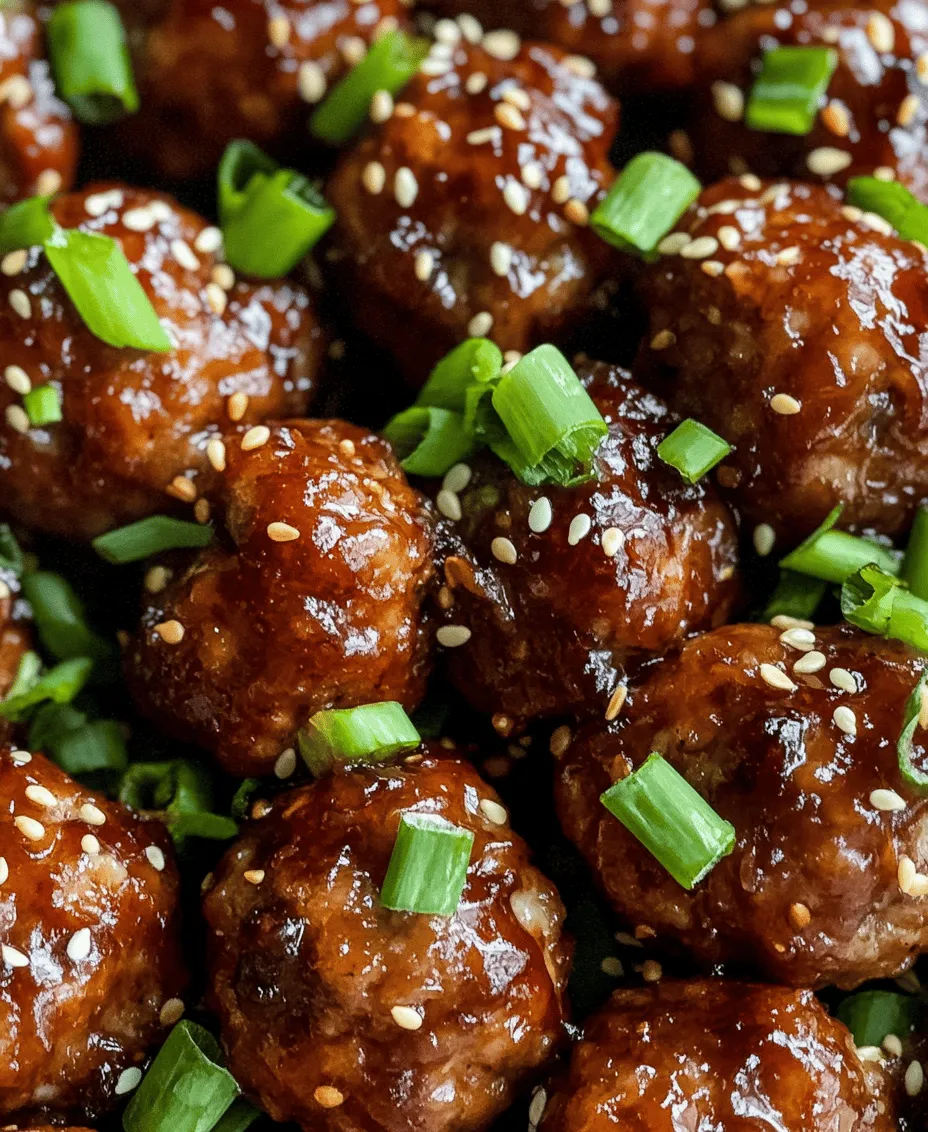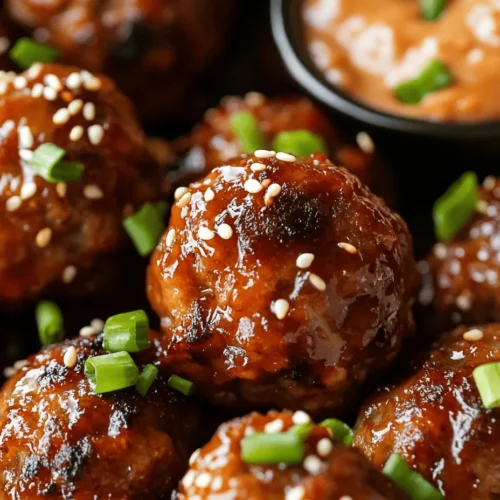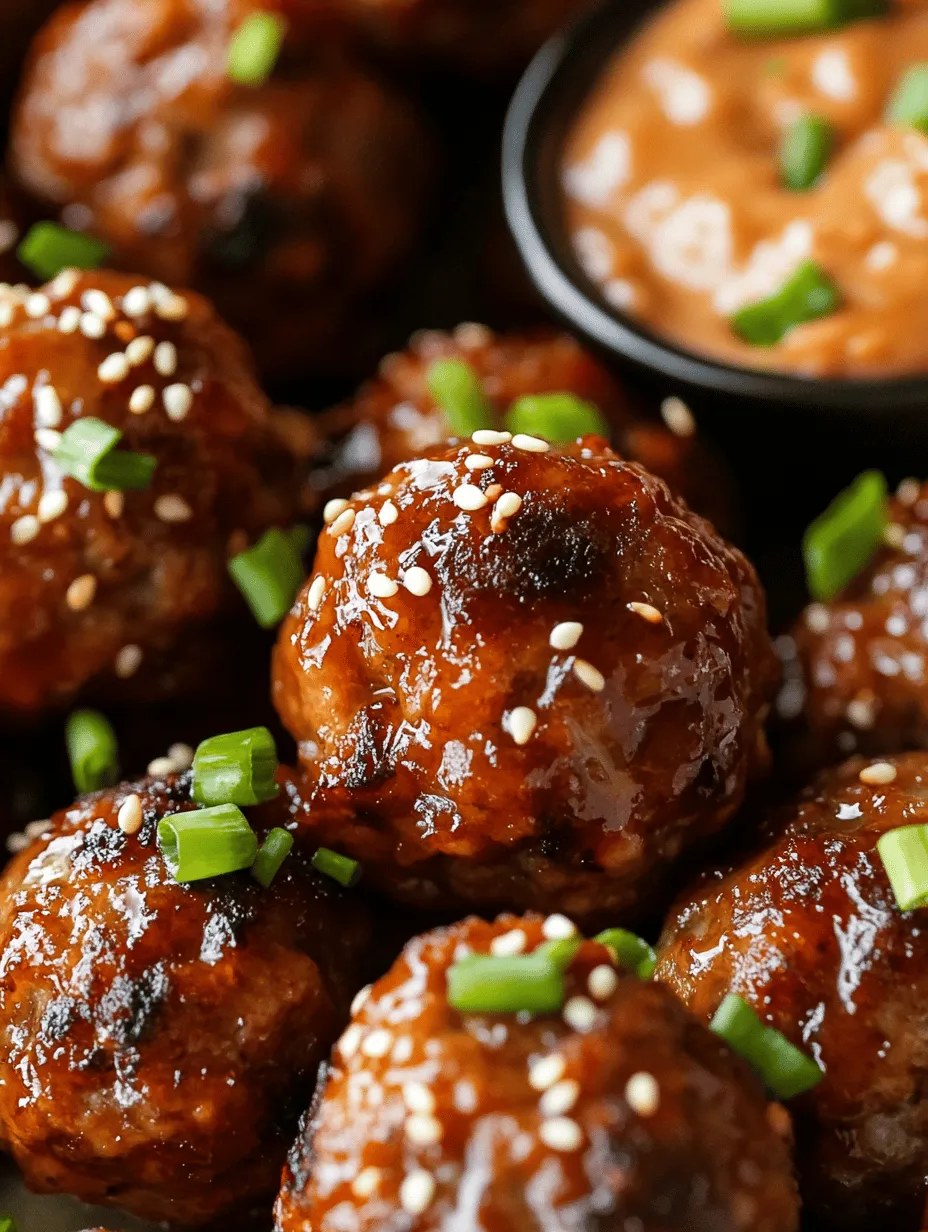Korean BBQ has taken the culinary world by storm, known for its rich flavors, vibrant colors, and mouthwatering dishes. Among these, Korean BBQ Meatballs with Spicy Mayo Dip stand out as a delightful fusion that combines the savory notes of traditional Korean cuisine with the comforting familiarity of classic meatballs. This dish is perfect for various occasions, whether you’re hosting a gathering, looking for a quick dinner solution, or simply wanting to indulge in something delicious.
In this article, we will take you step-by-step through the process of making these scrumptious meatballs from scratch. We’ll explore the unique ingredients that make this dish truly special, ensuring that your culinary adventure is both enjoyable and successful.
Understanding the Ingredients
To create the perfect Korean BBQ meatballs, it’s essential to understand the role of each ingredient. The combination of flavors, textures, and aromas is what elevates this dish, making it a favorite among many. Let’s dive into the core ingredients for the meatballs and the spicy mayo dip.
The Core Ingredients for Meatballs
Ground Meat Options: Exploring Beef, Pork, and Their Combination
The foundation of any meatball is, of course, the meat. For Korean BBQ meatballs, you can use a variety of ground meats, but the most popular choices are ground beef, ground pork, or a combination of both.
– Ground Beef: Offers a robust flavor and firmer texture, which pairs well with the sweetness of the sauce.
– Ground Pork: Provides a juicy and tender profile, contributing to the overall moisture of the meatball.
– Combination: Mixing both meats can yield the best of both worlds, balancing flavor and texture.
Choose high-quality meat with a bit of fat content to ensure your meatballs remain tender and flavorful during cooking.
The Role of Breadcrumbs: Why Panko is Preferred
Breadcrumbs are crucial for binding the meatball mixture while also contributing to its texture. When it comes to Korean BBQ meatballs, panko breadcrumbs are the preferred choice.
– Light and Airy: Panko is coarser than traditional breadcrumbs, allowing for a lighter texture in the final product.
– Absorption: Panko absorbs moisture without becoming too dense, ensuring your meatballs remain juicy and flavorful.
Using panko breadcrumbs can make a noticeable difference in achieving that perfect meatball consistency.
Essential Aromatics: The Importance of Garlic and Green Onions
No dish is complete without aromatics to enhance its flavor profile, and in Korean cuisine, garlic and green onions play a pivotal role.
– Garlic: Adds depth and a hint of sweetness, balancing the savory notes of the meat and sauce.
– Green Onions: Provide a fresh, slightly pungent flavor that brightens the dish and adds a pop of color.
Incorporating these aromatics into your meatball mixture not only elevates the flavor but also pays homage to traditional Korean cooking.
Flavor Enhancers: Soy Sauce, Brown Sugar, and Sesame Oil
To truly capture the essence of Korean BBQ, we must introduce some key flavor enhancers into our meatball mix.
– Soy Sauce: This staple ingredient adds umami richness and saltiness, creating a savory backbone for the meatballs.
– Brown Sugar: A touch of sweetness helps balance the salty and savory flavors, giving the meatballs a rich depth.
– Sesame Oil: Just a dash of this fragrant oil adds a nutty aroma that is synonymous with Korean cuisine, enhancing the overall flavor.
These ingredients come together to create a harmonious blend that makes each bite of the meatball an explosion of flavor.
The Heat Factor: Understanding Gochujang and its Adjustability
No Korean dish is complete without a bit of heat, and for this recipe, we turn to gochujang—a traditional Korean chili paste made from fermented soybeans, glutinous rice, and red chili powder.
– Flavor Profile: Gochujang brings a complex flavor that is both sweet and spicy, making it an excellent addition to the meatball mixture.
– Adjustability: Depending on your heat tolerance, you can adjust the amount of gochujang used. For a milder flavor, start with a small amount and increase it according to your preference.
Incorporating gochujang into your meatballs not only adds heat but also a depth of flavor that is unmistakably Korean.
Spicy Mayo Dip Essentials
To complement the rich flavors of the Korean BBQ meatballs, we’ll create a Spicy Mayo Dip that’s simple yet incredibly delicious. This dip adds a creamy, tangy element that pairs perfectly with the meaty goodness of our dish.
The Base: Why Mayonnaise Works Best
Mayonnaise serves as the perfect base for our dip due to its creamy texture and rich flavor.
– Creaminess: Provides a smooth mouthfeel that balances the spiciness of the other ingredients.
– Flavor Enhancer: Acts as a neutral base that allows other flavors to shine without overpowering them.
Using store-bought mayonnaise simplifies the process, but you can also make your own for an extra touch of freshness.
Adding Heat: The Impact of Sriracha
To infuse our mayo with that desired kick, we’ll add Sriracha—a popular hot sauce known for its balanced flavor profile.
– Spicy and Sweet: Sriracha adds a flavorful heat that complements the meatballs beautifully.
– Adjustable: Much like gochujang, you can modify the amount of Sriracha to suit your taste. Start with a tablespoon and add more as desired.
Balancing Flavors: The Role of Lemon Juice and Salt
To elevate the dip further, we’ll include a splash of lemon juice and a pinch of salt.
– Lemon Juice: Adds brightness and acidity, cutting through the richness of the mayonnaise and enhancing the overall flavor.
– Salt: A small pinch helps to bring out all the flavors in the dip, ensuring it’s well-seasoned without being overwhelming.
Garnishing Options for Visual Appeal
Presentation is key, and garnishing your Spicy Mayo Dip can make a significant difference. Consider the following options:
– Chopped Green Onions: Sprinkle some fresh green onions on top for a vibrant touch and added flavor.
– Sesame Seeds: Toasted sesame seeds add a delightful crunch and a nutty flavor that harmonizes with the overall dish.
These garnishes not only enhance the visual appeal of your dip but also contribute to its flavor and texture.
Step-by-Step Guide to Making Korean BBQ Meatballs
Now that we’ve covered the essential ingredients for our Korean BBQ meatballs and Spicy Mayo Dip, let’s move on to the detailed steps to bring this dish to life.
Preparing the Meatball Mixture
Tips for Mixing Ingredients Without Overworking the Meat
When preparing your meatball mixture, it’s crucial to handle the ingredients gently to avoid tough meatballs. Here are some tips:
– Use Your Hands: The best way to mix the meatball ingredients is by using your hands. This allows you to control the mixing process better and feel the texture of the mixture.
– Combine Gently: Combine the ground meat with the breadcrumbs, aromatics, and flavor enhancers until just mixed. Avoid overworking the mixture to keep the meatballs tender.
Achieving the Right Consistency for Perfect Meatballs
The consistency of your meatball mixture is essential for achieving the perfect texture. Here’s how to know when it’s just right:
– Formability: The mixture should hold together when shaped into a ball but still be slightly moist. If it’s too dry, add a splash of water or a little more mayonnaise to help bind it.
– Test a Small Batch: Before baking all your meatballs, consider frying a small test meatball to ensure the seasoning is perfect and the texture is just right.
Forming and Baking the Meatballs
Techniques for Shaping Uniform Meatballs
Uniformity in size helps ensure that your meatballs cook evenly. Here are a few techniques:
– Use a Cookie Scoop: A cookie scoop helps measure out equal portions of the mixture, ensuring consistent size.
– Wet Your Hands: Dipping your hands in water before shaping the meatballs prevents the mixture from sticking to your hands and makes the process smoother.
Optimal Baking Temperature and Time for Juiciness
To achieve the best results, the baking temperature and time are crucial.
– Preheat the Oven: Set your oven to 400°F (200°C). This temperature ensures that the meatballs cook through while developing a nice browned exterior.
– Baking Time: Bake the meatballs for about 20-25 minutes, depending on their size. They should be golden brown and cooked through, with an internal temperature of 160°F (70°C).
Creating the Spicy Mayo Dip
Instructions for Blending Ingredients Seamlessly
Making the Spicy Mayo Dip is quick and easy. Here’s how to do it:
1. Combine Ingredients: In a mixing bowl, combine mayonnaise, Sriracha, lemon juice, and salt.
2. Mix Thoroughly: Use a whisk or fork to blend the ingredients until smooth and creamy. Adjust the amount of Sriracha based on your preferred spice level.
3. Taste and Adjust: Taste the dip and adjust the seasoning if necessary, adding more lemon juice or salt to balance the flavors.
With these steps, you’re well on your way to creating a delicious dish that embodies the vibrant flavors of Korean BBQ. Get ready to serve your Korean BBQ meatballs with the spicy mayo dip for an unforgettable culinary experience.

Adjusting Spice Levels to Cater to Different Palates
One of the most appealing aspects of Korean BBQ Meatballs is their versatility, particularly in how the spice levels can be adjusted to suit different taste preferences. If you’re preparing this dish for guests or family members who may have varying tolerances for heat, there are several effective strategies to consider.
– For Mild Palates: If you or your guests prefer a milder flavor, reduce the amount of gochujang or use a milder chili paste. You can also balance the heat by adding additional sweet ingredients, such as a touch of honey or brown sugar, to the meat mixture. This will create a sweeter profile that can offset the spiciness.
– For Moderate Spice: Maintain the original amount of gochujang as specified in the recipe. This level of spice typically appeals to most people and provides that signature Korean flavor without overwhelming the palate.
– For Heat Seekers: To kick things up a notch, consider doubling the amount of gochujang or incorporating red pepper flakes into the meatball mixture or the spicy mayo dip. Additionally, adding finely chopped fresh chili peppers, such as jalapeños or Thai chilies, will amplify the heat and add a fresh, zesty element.
Serving Suggestions and Pairings
Presentation Ideas for Serving Meatballs
When it comes to serving your Korean BBQ Meatballs, presentation can elevate your dish from ordinary to extraordinary. Here are some creative ideas:
– Garnishing with Sesame Seeds and Green Onions: A simple yet effective way to enhance the visual appeal of your meatballs is by garnishing them with toasted sesame seeds and finely chopped green onions. The sesame seeds add a delightful crunch and nutty flavor, while the green onions provide a fresh, vibrant color contrast.
– Creative Serving Options: Plates vs. Skewers: You can serve the meatballs on large platters for a family-style meal or thread them onto skewers for a fun, finger-food experience. Skewers are great for parties or casual gatherings, allowing guests to easily grab a meatball and dip it into the spicy mayo sauce.
Pairing Suggestions
To create a well-rounded meal, consider the following pairing options:
– Ideal Side Dishes: Steamed Rice vs. Lettuce Wraps: Steamed white or brown rice pairs perfectly with Korean BBQ Meatballs, providing a neutral base that complements the bold flavors of the dish. Alternatively, serve the meatballs in crisp lettuce wraps for a low-carb option that adds a refreshing crunch.
– Beverage Pairings: What Complements the Spicy Flavor?: For drinks, consider serving a light lager or a crisp white wine, such as a Sauvignon Blanc, which can balance the spice. If you prefer non-alcoholic options, a sweet iced tea or a refreshing cucumber-infused water can also be delightful complements.
Nutritional Information and Benefits
Nutritional Breakdown of Korean BBQ Meatballs
Understanding the nutritional content of your Korean BBQ Meatballs can help you enjoy this dish guilt-free. Here’s a breakdown of the typical components per serving:
– Caloric Content and Macronutrient Distribution: Each serving of Korean BBQ Meatballs typically contains around 250-300 calories, depending on the ingredients used. The macronutrient distribution is approximately:
– Protein: 20-25 grams
– Carbohydrates: 15-20 grams
– Fat: 10-15 grams
– Health Benefits of Key Ingredients: The main ingredients in your meatballs, such as ground meat (beef, chicken, or turkey), garlic, ginger, and green onions, provide essential nutrients. For instance, ground meat is an excellent source of protein, which is crucial for muscle repair and overall health. Garlic and ginger are known for their anti-inflammatory properties, while green onions are rich in vitamins A and C.
Understanding the Importance of Balanced Meals
Incorporating Korean BBQ Meatballs into a balanced diet can be both satisfying and nutritious. Here’s how you can make the most of this dish:
– How to Incorporate Meatballs into a Healthy Diet: Serve your meatballs with plenty of vegetables, whether in a stir-fry or as a side salad, to boost fiber intake. Pairing the meatballs with whole grains, such as brown rice or quinoa, can also enhance the nutritional profile of your meal.
– The Role of Protein and Vegetables in Meal Planning: Protein is essential for muscle maintenance and energy, while vegetables provide vital vitamins and minerals. By balancing your plate with both protein-rich meatballs and a variety of colorful vegetables, you can create a fulfilling meal that supports overall health.
Cultural Significance of Korean BBQ
A Brief History of Korean BBQ
Korean BBQ is not just a cooking method; it’s a cultural experience steeped in tradition. The roots of BBQ in Korean culture can be traced back centuries, with communal dining being a significant aspect of Korean society.
– The Roots of BBQ in Korean Culture: Historically, Korean BBQ began as a way to prepare and enjoy meat, particularly during special occasions and festivals. The technique of grilling meat over an open flame is thought to have developed as a way to preserve the meat while imparting a unique smoky flavor.
– How Korean BBQ Evolved into Modern Dishes: Over the years, Korean BBQ has evolved into a globally recognized cuisine, with dishes like bulgogi and galbi gaining popularity. The introduction of flavors and techniques from various regions has only enriched the tradition, leading to the creation of modern dishes like Korean BBQ Meatballs.
Exploring Korean Culinary Traditions
Korean meals are often characterized by their communal nature, reflecting the importance of family and sharing.
– The Importance of Family and Sharing in Korean Meals: In Korea, meals are usually enjoyed with family and friends, emphasizing togetherness. Dishes are often served family-style, allowing everyone to share and connect over food. This tradition is beautifully encapsulated in the act of sharing Korean BBQ Meatballs.
– Traditional Ingredients and Cooking Techniques: Korean cuisine relies heavily on fresh, seasonal ingredients. Techniques such as fermentation (for kimchi) and grilling are foundational. The use of ingredients like gochujang and sesame oil highlights the bold flavors that define Korean cooking.
Conclusion: The Joy of Cooking Korean BBQ Meatballs
Korean BBQ Meatballs with Spicy Mayo Dip offer a unique culinary experience that is both flavorful and easy to prepare. By understanding the ingredients and following the simple steps outlined in this article, you can create a dish that not only satisfies hunger but also brings a taste of Korean culture to your table. Enjoy the process of cooking and the joy that comes with sharing delicious food with family and friends.
Whether you opt for a traditional serving method or get creative with presentation, these meatballs are sure to impress. Embrace the versatility of spice levels, explore pairing options, and delve into the cultural significance of this beloved dish. As you gather around the table with loved ones, relish the flavors and the moments created—because cooking is not just about food; it’s about connection and celebration.


